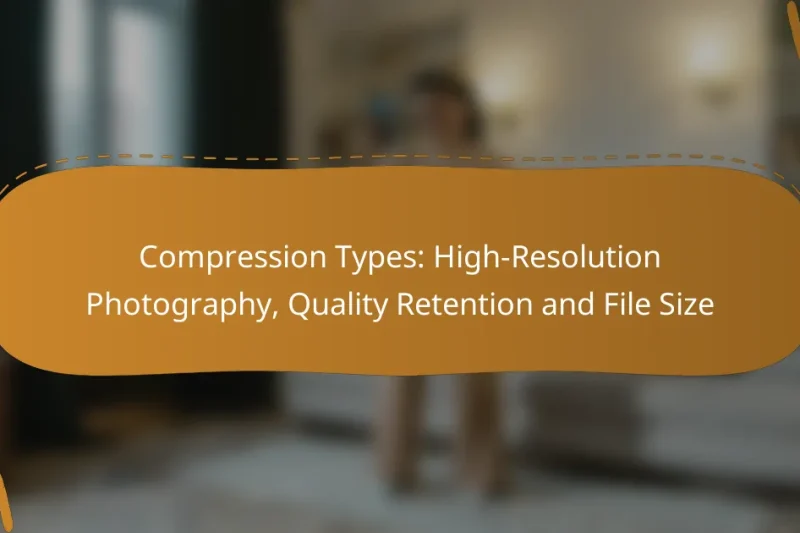Combining lossless and lossy compression techniques can lead to significant performance gains by optimizing file sizes … Combining Compression Techniques: Lossless, Lossy and Performance GainsRead more
Lossless vs. Lossy Compression: Which Is Better and When to Use
Understanding the differences between lossless and lossy compression is crucial for selecting the right method for your needs. Lossless compression retains all original data, making it perfect for applications where quality is paramount, while lossy compression sacrifices some data to achieve smaller file sizes, often suitable for media where perfect fidelity is less critical. Knowing when to use each type can significantly impact the efficiency and quality of your digital files.
Lossy Compression: Best Scenarios for Social Media Marketing
Lossy compression plays a vital role in social media marketing by optimizing images and videos for … Lossy Compression: Best Scenarios for Social Media MarketingRead more
Lossless vs. Lossy Compression: Which Is Better and When to Use
Understanding the difference between lossless and lossy compression is essential for optimizing file storage and quality. … Lossless vs. Lossy Compression: Which Is Better and When to UseRead more
Compression Types: High-Resolution Photography, Quality Retention and File Size
In high-resolution photography, selecting the appropriate compression type is crucial for achieving an optimal balance between … Compression Types: High-Resolution Photography, Quality Retention and File SizeRead more
What is lossless compression?
Lossless compression is a method of reducing file size without sacrificing any data quality. This technique allows for the original data to be perfectly reconstructed from the compressed file, making it ideal for applications where fidelity is crucial.
Definition of lossless compression
Lossless compression works by identifying and eliminating redundancy in data. It uses algorithms that compress files by encoding information more efficiently, allowing the exact original data to be restored when decompressed. This is particularly important for text, images, and audio where any loss of information can degrade quality.
Examples of lossless formats
Common lossless formats include PNG for images, FLAC for audio, and ZIP for general file compression. Each of these formats retains all original data, making them suitable for professional use where quality cannot be compromised. For instance, PNG is preferred for graphics with sharp edges, while FLAC is favored by audiophiles for music preservation.
What is lossy compression?
Lossy compression is a method of reducing file size by permanently eliminating certain data, which can result in a loss of quality. This technique is commonly used in audio, video, and image files where a perfect reproduction is not necessary.
Definition of lossy compression
Lossy compression works by removing less critical information from the original file, allowing for significant size reduction. The process is designed to exploit the limitations of human perception, meaning that the removed data is often imperceptible to the average user.
This type of compression is particularly effective for media files, where slight quality degradation may not be noticeable during playback or viewing. However, once data is discarded, it cannot be recovered, making it essential to consider the acceptable quality level before applying this method.
Examples of lossy formats
Common examples of lossy formats include JPEG for images, MP3 for audio, and MPEG for video. Each of these formats uses different algorithms to compress files while maintaining a balance between size and quality.
For instance, a JPEG image can be significantly smaller than a PNG file, making it ideal for web use where loading speed is crucial. Similarly, MP3 files are widely used for music streaming due to their reduced file size compared to lossless formats like WAV, which retain all original audio data.
When should I use lossless compression?
Lossless compression should be used when maintaining the original quality of data is essential. This method is ideal for text files, images, and audio where any loss of information could be detrimental.
Best use cases for lossless compression
Lossless compression is best suited for scenarios where data integrity is critical. Common use cases include archiving documents, compressing images for professional printing, and storing audio files for music production. Formats like PNG for images and FLAC for audio are popular choices in these contexts.
Additionally, lossless compression is advantageous for software distribution, where the exact byte-for-byte reproduction of files is necessary. This ensures that programs run correctly without any corruption or errors.
Advantages of lossless compression
The primary advantage of lossless compression is that it allows for the original data to be perfectly reconstructed. This is crucial for applications that require high fidelity, such as medical imaging or legal documentation. Users can compress files without sacrificing quality.
Another benefit is that lossless formats often support a wide range of data types, making them versatile for various applications. Furthermore, lossless compression can lead to significant storage savings, often reducing file sizes by 10-50% without any loss of quality.
When should I use lossy compression?
Lossy compression is ideal when file size reduction is more critical than retaining the original quality. This method is commonly used for audio, video, and images where some loss of detail is acceptable to achieve smaller file sizes.
Best use cases for lossy compression
Lossy compression is best suited for streaming media, such as music and videos, where bandwidth is limited. It is also effective for web images, allowing faster loading times without significantly affecting user experience. Examples include JPEG for images and MP3 for audio files.
Advantages of lossy compression
The primary advantage of lossy compression is the significant reduction in file size, often by 50% or more, which saves storage space and improves loading speeds. This efficiency makes it easier to share files over the internet or store them on devices with limited capacity.
Another benefit is that lossy formats often support high-quality playback at lower bitrates, making them suitable for casual listening or viewing. However, it is essential to balance quality and size to avoid noticeable degradation in critical applications.
How do lossless and lossy compression compare?
Lossless and lossy compression are two methods of reducing file sizes, each with distinct advantages and use cases. Lossless compression retains all original data, making it ideal for applications where quality is paramount, while lossy compression sacrifices some data for significantly smaller file sizes, suitable for scenarios where speed and storage are critical.
Key differences between lossless and lossy
The primary difference between lossless and lossy compression lies in data preservation. Lossless compression techniques, such as ZIP or FLAC, allow for the complete recovery of the original file, making them suitable for text documents, images, and audio where quality is essential. In contrast, lossy compression, used in formats like JPEG or MP3, permanently removes some data to achieve smaller file sizes, which can be acceptable for casual use or streaming.
Another key distinction is the resulting file size. Lossless formats typically yield larger files, often 20-50% larger than their lossy counterparts. This trade-off is crucial when considering storage limitations or bandwidth constraints.
Performance comparison
In terms of performance, lossy compression generally offers faster processing speeds, making it preferable for real-time applications like video streaming or online gaming. Lossy formats can reduce file sizes by 60-90%, allowing for quicker uploads and downloads, which is vital in today’s fast-paced digital environment.
Conversely, lossless compression may require more processing power and time to encode and decode files, but it ensures that the integrity of the data remains intact. This is particularly important in professional settings, such as graphic design or audio engineering, where quality cannot be compromised.
What factors influence the choice between lossless and lossy?
The choice between lossless and lossy compression depends on factors such as file size, quality requirements, and the intended use of the compressed files. Understanding these factors helps determine the best compression method for your specific needs.
File size considerations
File size is a crucial factor when choosing between lossless and lossy compression. Lossy compression typically reduces file sizes significantly, often by 50% or more, making it ideal for applications where storage space is limited, such as streaming services. In contrast, lossless compression retains the original file quality but results in larger file sizes, usually compressing files by 10-30%.
When deciding, consider the storage capacity of your devices and the bandwidth available for file transfers. For example, if you are working with high-resolution images or audio files, lossy formats like JPEG or MP3 can save considerable space without a noticeable drop in quality for everyday use.
Quality requirements
Quality requirements play a significant role in the decision between lossless and lossy compression. Lossless formats, such as FLAC for audio or PNG for images, maintain the original quality and are preferred in professional settings where fidelity is critical, like music production or graphic design. Lossy formats, while more space-efficient, may introduce artifacts that can be noticeable, especially at lower bit rates.
For general use, lossy compression is often sufficient, particularly for casual listening or viewing. However, if the end product requires high precision, such as archival purposes or professional presentations, opt for lossless compression to ensure the highest quality is preserved.
What are the emerging trends in compression technology?
Emerging trends in compression technology focus on enhancing efficiency and speed while maintaining data integrity. Innovations in algorithms and machine learning are driving these advancements, making compression more effective across various applications.
Advancements in compression algorithms
Recent advancements in compression algorithms include the development of neural network-based techniques that adaptively learn from data patterns. These algorithms can achieve higher compression ratios compared to traditional methods, particularly in image and video compression.
For instance, algorithms like Google’s Zopfli and Facebook’s Zstandard have shown significant improvements in both speed and efficiency. They can compress data to lower sizes without sacrificing quality, making them suitable for real-time applications.
Future applications of compression techniques
The future of compression techniques lies in their application in areas such as cloud storage, streaming services, and Internet of Things (IoT) devices. As data generation continues to grow, efficient compression will be crucial for optimizing bandwidth and storage costs.
For example, in cloud storage, advanced compression can reduce costs significantly by minimizing the amount of data stored. In streaming, improved compression methods can enhance user experience by reducing buffering times and improving video quality, especially in mobile environments.



